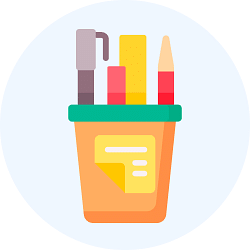Transport and Communication Class 4 Notes SST
We can travel from one corner of the country to another in a few hours. We can communicate with people living thousands of kilometres away in seconds. All these have been made possible by modern means of transport and communication.
Transport
Early humans travelled on foot. Then they invented the wheel and started making carts. These were pulled by animals. However, these were slow modes of transport. Today there are fast modes of transport which can cover longer distances in very less time. India has a well-developed network of transport.
Roadways
Our country has a large network of roads. The roads are either metalled or unmetalled. Most roads in cities and towns are metalled. They are made of stone, cement and tar. Unmetalled roads are generally found in villages. The national highways are constructed and maintained by the central government. The state highways are maintained by the state governments.
The national highways are constructed and maintained by the central government. The state highways are maintained by the state governments.
The most important roads in India are the national highways and the state highways. The national highways connect state capitals, and other big cities and towns. The state highways connect cities and towns within a state with the national highways.
Railways
Railways are the lifeline of our country. They connect all parts of India. At the time of Independence, trains were run by steam engines. These were replaced by diesel and electric engines. This increased the speed of trains. Nowadays trains such as Rajdhani Express and Shatabdi Express travel at a speed of 120–130 kilometres per hour.
In some cities, there are Metro trains. These trains move on elevated or underground tracks. Mumbai has a well-connected network of local trains.
Edurev Tips:
The Palace on Wheels, the Maharajas’ Express and the Deccan Odyssey are names of luxury trains in India. These trains are popular with foreign tourists.
Waterways
Water transport is the cheapest mode of transport and most suitable for transporting heavy goods. Passenger ships carry people. Cargo ships transport goods. Tanker ships carry petroleum and oil.
Along India’s coastline there are 13 major and nearly 200 minor ports. The Deendayal Port (Gujarat) and the Paradip Port (Odisha) handle a large quantity of cargo.
Airways
Aeroplanes are the fastest mode of transport. Major cities and towns of India are connected by airways. Aeroplanes transport people and goods, especially perishable goods such as fresh fruits, flowers and vegetables, to far-off places. Some aeroplanes also carry mail. Both government and private airlines operate in our country.
Helicopters are used in areas that are difficult to reach. They are used to drop food and medicines, and rescue people during natural disasters.
Communication
Sending and receiving messages is called communication. Long ago, messages took many days or weeks to reach. Today they reach in seconds.
Postal service
India’s postal service is called India Post. It is the largest postal network in the world. People go to a post office to buy stamps, inland letters, postcards and stamped envelopes. Letters and parcels are either sent through ordinary post or through a faster service called Speed Post. The hobby of collecting postcards is called deltiology.
The hobby of collecting postcards is called deltiology.
Telephone
We can talk to people in any part of the world over the telephone. Landline phones, however, are no longer popular. They have been replaced by mobile phones. Smartphones are all-in-one devices with which we can do many things.
Fax
A written document can be sent through a fax machine. It takes only a few seconds to reach. The fax machine is connected to a telephone line. A fax machine
A fax machine
Internet and email
We can sit at home, access any website, and get information on any topic through the Internet. Email or electronic mail, sent through the Internet, has made communication faster and cheaper. Nowadays many people access Internet on their smartphones. They also exchange messages through apps and social networking sites.
Radio
A programme on radio reaches all corners of India. It is useful even to those people who cannot read and write. The All India Radio broadcasts news and educational programmes in Hindi, English and in many regional languages. Private FM channels also broadcast programmes for the people.
Television
Television performs the same task as a radio, but also shows pictures. Sitting at home you can watch what is happening in other parts of our country and elsewhere in the world. Today there are many television channels in India.
Cinema
Movies are made in many languages. They educate as well as entertain. They also spread social messages.
Newspapers and magazines
A large number of newspapers and magazines are published in India. These carry news and information about events from all parts of the world. Some people read e-newspapers on their tablets and smartphones.
|
53 videos|44 docs|59 tests
|
FAQs on Transport and Communication Class 4 Notes SST
| 1. What are the different modes of transport? |  |
| 2. How does road transport help in the movement of goods and people? |  |
| 3. What are the advantages of air transport? |  |
| 4. How does water transport contribute to the economy? |  |
| 5. How has communication evolved over time? |  |

|
Explore Courses for Class 4 exam
|

|

















